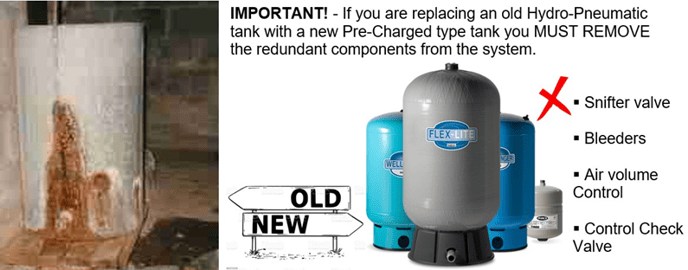How do deep well air volume controls (AVC), a.k.a. air release valves, work?
Your pressure system will have either of two basic types of pressure tanks: captive air tanks (a.k.a. pre-charged or bladder tanks) or less commonly, a hydro pneumatic tank (a.k.a. atmospheric tank).

Air volume controls, snifter valves, and bleeders are ONLY used on pumping systems with hydro pneumatic or atmospheric tanks. If you decide to replace an old hydro pneumatic tank with a pre-charged tank you MUST REMOVE the redundant components!

Hydro pneumatic tanks use the air within the tank to maintain pressure on the water system. Air, unlike water, can be compressed and acts like a giant spring which pushes the water from the tank providing water between the pump cycles (drawdown). Over time, the captive air can be absorbed into the water, reducing the internal tank pressure and useable water between pump cycles. This will eventually result in a waterlogged tank. The remedy is to drain the tank so the air is replaced or to pump air into the system through an air valve.
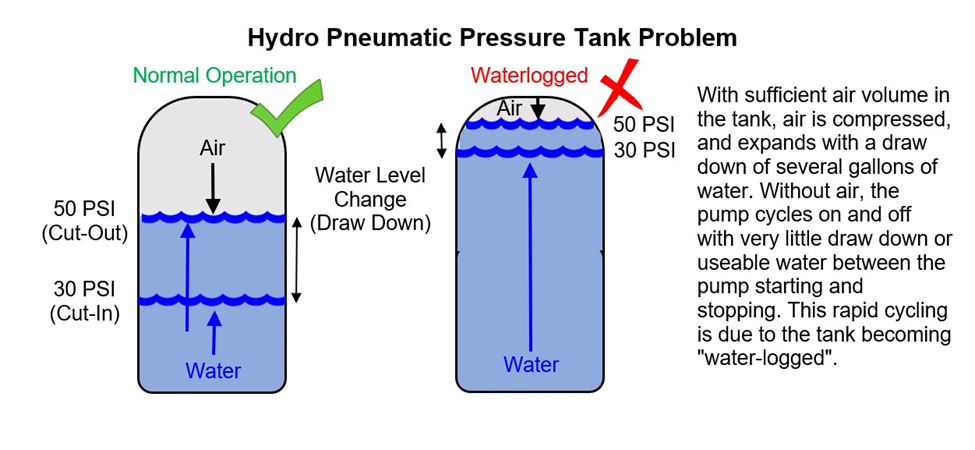
In deep well installations, the submersible pump is installed down the well and pushes the water up from the well to the surface. These deep well systems, depending on the type and model of pump, will pump water from depths up to 1200 ft. To ensure the hydro pneumatic tank does not become waterlogged a bleeder system is required to replenish the air in the tank with each pump cycle.
Why is an AVC required?
Because the snifter valve/bleeder system will usually push more air into the water tank than is needed, an AVC mounted on the water pressure tank is also installed. The AVC will purge excess air from the water tank to the atmosphere through a port on the AVC as necessary. If you hear air hissing from the AVC’s air purge valve port, that's normal. But if you see water leaking out of the AVC, that means it needs a repair or more likely, replacement.
Types of Deep Well AVCs
There are several different styles of AVCs available. NOTE: Gauges are sold separately! There are two basic types of deep well AVCs:
(A) with an adjustable air release valve
(B) without an adjustable air release valve
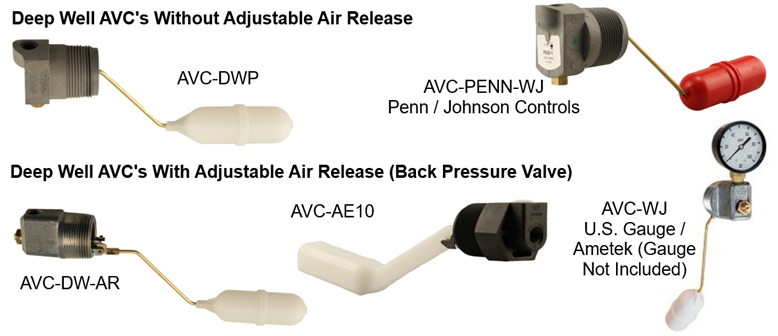
ALL TYPES ALLOW AIR TO ESCAPE FROM THE TANK UNTIL THE DESIRED WATER LEVEL HAS BEEN REACHED!
Deep Well AVC Air Release Operation
When there is an excess of air and the water level is low, the float opens the main valve of the control, which exhausts the excess air to the atmosphere. As the float rises with the increase in water level the main valve closes, trapping the remaining volume of air in the tank. The optimum relationship between the volume of air and water in the tank is thus maintained at all times.

Deep Well Installations – Bleeder Systems WITH Deep Well AVC
These installations all require a bleeder system to “charge air” into the tank. A bleeder is installed in the drop pipe in the well below frost level (typically 10 - 20 ft down). Each time the pump stops the water is drained back into the well down to the port in the bleeder. The bronze check valve (on which the snifter valve is mounted) keeps water in the pressure tank from draining back down into the well when the well pump has stopped. The purpose of the snifter valve is to break the vacuum and let air enter into the piping so that the water can drain. Each time the pump starts the air that is trapped in the top section of pipe is forced into the tank. The valves in both the snifter and bleeder will close under the pumps pressure so that the water does not escape during the pumping cycle.
Deep Well Bleeder Air Charging System
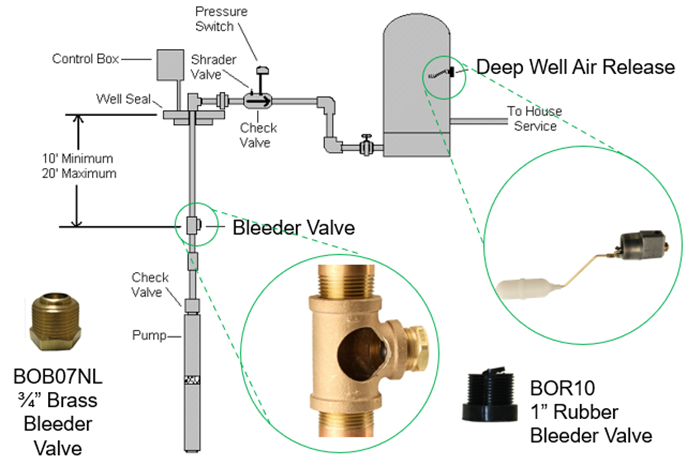
What is the benefit of the adjustable air release valve?
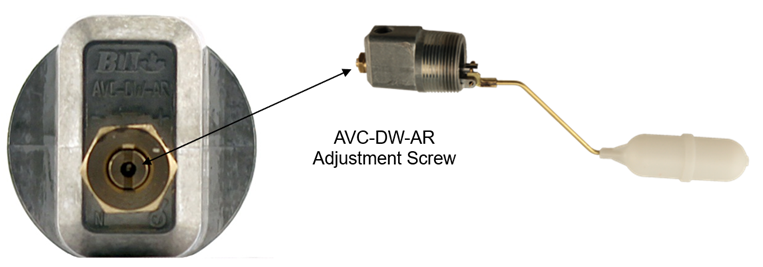
Operation of deep well AVC with air release valve (Model: AVC-DW-AR):
The air release (back pressure) valve can be adjusted to prevent air from escaping from the tank by creating back pressure to trap air even though the float is holding the valve open. This allows the installer to maintain a greater volume of air in the tank and obtain higher draw down capacity (useable gallons of water between pump cycles).
Adjusting the back pressure:
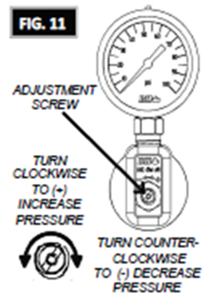 The air release valves are factory set at approximately 25 PSI (+/-10%), a setting that provides satisfactory performance in most installations.
The air release valves are factory set at approximately 25 PSI (+/-10%), a setting that provides satisfactory performance in most installations.
Adjustment can be made to release air anywhere between 0-40 PSI.
In the event that air escapes through the service lines (i.e. air blowing at faucets) after the system is in operation for some time, the venting back pressure is set too high, causing the tank to retain too much air. To decrease venting pressure, turn the adjustment screw to the left (counter-clockwise). In the event that the pump cycles too often the venting back pressure is set too low and should be increased. To increase pressure turn the adjustment screw to the right (clockwise). Caution: Do NOT turn the adjustment screw out of the valve housing. Small internal parts could be lost.
NOTE: Make only very fine adjustments. Constantly monitor the gauge pressure while the air is venting, this indicates the back pressure setting.
SETTING GUIDE - Every 10 degrees will change the back pressure by approximately 1.1 PSI. A 1/4 quarter turn will change the setting by approximately 5 PSI. Caution: Adjustment of this air release beyond 40 PSI is possible, however it is not recommended!
What happens if one of the components in the air charging/air release system stops working?
There are a number of things that can going wrong with a bleeder, check valve, snifter valve, and air volume control system.
All of these components must work perfectly to maintain the correct air volume in the tank. If either the bleeder orifice, above ground check valve, or the snifter valve are not working, the tank will become "waterlogged" and the pump will cycle on and off very rapidly.
You should hear hissing sounds for a short period of time when the pump starts. Hissing air at the air volume control means that the control is releasing excess air from inside of the pressure tank. You should be concerned when you do not hear the air hissing noise. Usually, the check valve stops holding properly, leaking back and pressurizing the drop pipe. The bleeder in the well then cannot open to drain the pipe to re-charge with air for the next injection on pump start up in the next pumping cycle. If this happens then you won't hear air coming into the tank, and soon your tank will become waterlogged, and the pump starts cycling on and off too often.
Rapid repeated cycling due to a waterlogged tank will damage and ultimately cause your pump to fail.
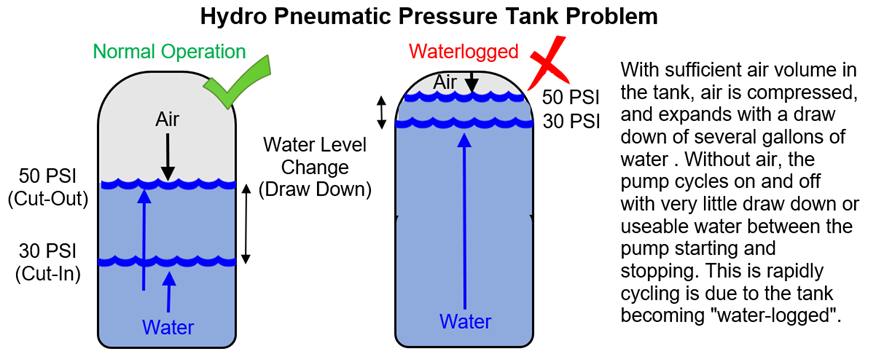
Temporary Fix for a Waterlogged Tank Condition:
You can manually add air into the tank to correct a water-logged condition as a temporary solution until the cause of the problem can be identified and repaired properly. The link below provides instruction on how to add air:
IMPORTANT – Frequency of Pump Starts:
The average number of starts per day over a period of months or years influences the life of a submersible pumping system. Excessive cycling affects the life of control components such as pressure switches, starters, relays, and capacitors. Rapid cycling can also cause motor spline damage, bearing damage, and motor overheating. All these conditions can lead to reduced motor life.
The pump size, tank size, and other controls should be selected to keep the starts per day as low as practical for the longest life. One must verify and set up a system that is within the maximum number of starts per 24-hours as per the pump or submersible motor manufacturers guidelines. Typically, motors should run a minimum of one minute to dissipate heat buildup from the starting current. The longer the time between pump starts the better it is for your pump. Larger motors should have a minimum of 15 minutes between starts or starting attempts.
If the air release stops working, you will have too much air in the tank resulting in blowing of air at the faucets! Too much air means your AVC is not working. Usually, it is a result of iron build up clogging the valve, or after extended periods of time in aggressive water the float rod on the inside of the tank corrodes off and falls in the tank. Then you may see water leaking out of the air volume control which means it needs to be replaced.
Due to the complexity of air charging systems on hydropneumatics tanks, most pressure systems have been converted to pre-charged (captive air) diaphragm or bladder type tanks. With pre-charged there is no air charge system to maintain. If you make the switch to a pre-charged tank, you must get rid of all those air charging components, or you may have air where it shouldn't be.
